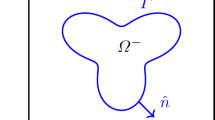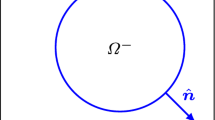Abstract
In this paper, we apply the immersed interface method (IIM) and the hierarchical derivative matching (HDM) method, respectively, to restore the accuracy of the high-order alternating direction implicit finite-difference time-domain (ADI-FDTD) scheme of the 2D Maxwell’s equations with material interfaces. For the case of discontinuous permittivity \(\varepsilon \) and continuous permeability \(\mu \), we propose four high-order schemes. Two of them are of second order in time and fourth order in space (ADI-IIM-FDTD(2,4) scheme and ADI-HDM-FDTD(2,4) scheme). Others are of fourth order both in time and space (ADI-IIM-FDTD(4,4) scheme and ADI-HDM-FDTD(4,4) scheme). For the case of discontinuous permittivity \(\varepsilon \) and permeability \(\mu \), the (2,4) scheme and the (4,4) scheme are constructed as well (ADI-HDM-FDTD-X(2,4) scheme and ADI-HDM-FDTD-X(4,4) scheme). The proposed six schemes maintain the advantages of ADI-FDTD method such as unconditional stability and computational efficiency. Numerical examples are given to verify the performance of the proposed schemes.




Similar content being viewed by others
Data Availability Statement
The datasets generated during and/or analyzed during the current study are available from the corresponding author on reasonable request.
References
Chen, W., Li, X., Liang, D.: Energy-conserved splitting FDTD methods for Maxwell’s equations. Numer. Math. 108, 445–485 (2008)
Deng, S.: On the immersed interface method for solving time-domain Maxwell’s equations in materials with curved dielectric interfaces. Comput. Phys. Commun. 179, 791–800 (2008)
Deng, S., Li, Z., Pan, K.: An ADI-Yee’s scheme for Maxwell’s equations with discontinuous coefficients. J. Comput. Phys. 438, 110356 (2021)
Driscoll, T.A., Fornberg, B.: A block pseudo-spectral method for Maxwell’s equations I. One-dimensional case. J. Comput. Phys. 140(1), 47–65 (1998)
Driscoll, T.A., Fornberg, B.: Block pseudo-spectral methods for Maxwell’s equations II: two-dimensional discontinuous-coefficient case. SIAM J. Sci. Comput. 21, 1146–1167 (1999)
Feng, H., Long, G., Zhao, S.: An augmented matched interface and boundary (MIB) method for solving elliptic interface problem. J. Comput. Appl. Math. 361, 426–443 (2019)
Feng, H., Zhao, S.: A fourth order finite difference method for solving elliptic interface problems with the FFT acceleration. J. Comput. Phys. 419, 109677 (2020)
Fornberg, B.: Calculation of weights in finite difference formulas. SIAM Rev. 40(3), 685–691 (1998)
Hirono, T., Lui, W., Seki, S., Yoshikuni, Y.: A three-dimensional fourth-order finite-difference time-domain scheme using a symplectic integrator propagator. IEEE Trans. Microw. Theory Tech. 49(9), 1640–1648 (2001)
Hirono, T., Yoshikuni, Y.: Accurate modeling of dielectric interfaces by the effective permittivities for the fourth-order symplectic finite-difference time-domain method. Appl. Opt. 46(9), 1514–1524 (2007)
Hwang, K.P., Cangellaris, A.C.: Effective permittivities for second-order accurate FDTD equations at dielectric interfaces. IEEE Microwaves Wirel. Commun. 11(4), 158–160 (2001)
Kong, Y., Chu, Q., Li, R.: High-order unconditionally stable two-step leapfrog ADI-FDTD methods and numerical analysis. IEEE Trans. Antennas Propag. 61(10), 5135–5143 (2013)
Law, Y.M., Marques, A.N., Nave, J.C.: Treatment of complex interfaces for Maxwell’s equations with continuous coefficients using the correction function method. J. Sci. Comput. 82, 56 (2020). https://doi.org/10.1007/s10915-020-01148-6
Li, Z., Mayo, A.: ADI methods for heat equations with discontinuities along an arbitrary interface. Am. Math. Soc. 48(1), 311–315 (1993)
Liang, D., Yuan, Q.: The spatial fourth-order energy-conserved S-FDTD scheme for Maxwell’s equations. J. Comput. Phys. 243, 344–364 (2013)
Liu, J., Zheng, Z.: A dimension by dimension splitting immersed interface method for heat conduction equation with interfaces. J. Comput. Appl. Math. 261, 221–231 (2014)
Liu, Q., Chen, Z., Yin, W.: An arbitrary-order LOD-FDTD method and its stability and numerical dispersion. IEEE Trans. Antennas Propag. 57(8), 2409–2417 (2009)
Namiki, T.: A new FDTD algorithm based on alternating-direction implicit method. IEEE Trans. Microwave Theory Tech. 47(10), 441–443 (1999)
Nguyen, D.D., Zhao, S.: Time-domain matched interface and boundary (MIB) modeling of Debye dispersive media with curved interfaces. J. Comput. Phys. 278, 298–325 (2014)
Shibayama, J., Muraki, M., Yamauchi, J., Nakano, H.: Efficient implicit FDTD algorithm based on locally one-dimensional scheme. Electron. Lett. 41(19), 1046–1047 (2005)
Tan, E.L.: ADI-FDTD method with fourth order accuracy in time. IEEE Microwave Wirel. Componet. 18(5), 296–298 (2008)
Virta, K., Mattsson, K.: Acoustic wave propagation in complicated geometries and heterogeneous media. J. Sci. Comput. 61, 90–118 (2014)
Wei, Z., Li, C., Zhao, S.: A spatially second order alternating direction implicit (ADI) method for solving three dimensional parabolic interface problems. Comput. Math. Appl. 75(6), 2173–2192 (2018)
Wiegmann, A., Bube, P.: The explicit-jump immersed interface method: finite difference methods for PDEs with piecewise smooth solutions. SIAM J. Numer. Anal. 37(3), 827–862 (2000)
Xie, Z., Chan, C., Zhang, B.: An explicit fourth-order stagger finite-difference time-domain method for Maxwell’s equations. J. Comput. Appl. Math. 147(1), 75–98 (2002)
Yee, J.S.: Numerical solution of initial boundary value problems involving Maxwell’s equation in isotropic media. IEEE Trans. Antennas Propag. 3(14), 302–307 (1966)
Yefet, A., Petropoulos, P.G.: A non-dissipatibe staggered fourth-order accurate explicit finite difference scheme for the time-domain Maxwell’s equations. J. Comput. Phys. 168, 286–315 (2001)
Yefet, A., Turkel, E.: Fourth order compact implicit method for the Maxwell equations with discontinuous coefficients. Appl. Numer. Math. 33, 125–134 (2000)
Zhang, Y., Nguyen, D.D., Du, K., Xu, J., Zhao, S.: Time-domain numerical solutions of Maxwell interface problems with discontinuous electromagnetic waves. Adv. Appl. Math. Mech. 8(3), 353–385 (2016)
Zhao, S.: High order matched interface and boundary methods for the Helmholtz equation in media with arbitrarily curved interfaces. J. Comput. Phys. 229, 3155–3170 (2010)
Zhao, S.: A matched alternating direction implicit (ADI) method for solving the heat equation with interfaces. J. Sci. Comput. 63(1), 118–137 (2015)
Zhao, S., Wei, G.: High-order FDTD methods via derivative matching for Maxwell’s equations with material interfaces. J. Comput. Phys. 200(1), 60–103 (2004)
Acknowledgements
W. Li’s work was supported by National Natural Science Foundation of China [Grant Numbers 11701282 and 61673011] and Natural Science Foundation of Jiangsu Province [Grant Number BK20160819].
Funding
Wanshan Li’s work was supported by National Natural Science Foundation of China (11701282 and 61673011) and Natural Science Foundation of Jiangsu Province (BK20160819).
Author information
Authors and Affiliations
Corresponding author
Ethics declarations
Conflict of interest
No conflict of interest is involved with this research.
Additional information
Publisher's Note
Springer Nature remains neutral with regard to jurisdictional claims in published maps and institutional affiliations.
Rights and permissions
Springer Nature or its licensor holds exclusive rights to this article under a publishing agreement with the author(s) or other rightsholder(s); author self-archiving of the accepted manuscript version of this article is solely governed by the terms of such publishing agreement and applicable law.
About this article
Cite this article
Gong, N., Li, W. High-Order ADI-FDTD Schemes for Maxwell’s Equations with Material Interfaces in Two Dimensions. J Sci Comput 93, 51 (2022). https://doi.org/10.1007/s10915-022-02011-6
Received:
Revised:
Accepted:
Published:
DOI: https://doi.org/10.1007/s10915-022-02011-6




